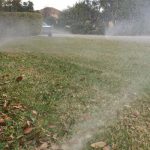From hauntingly humorous to truly terrifying, garden tales of misery and woe hover and haunt unsuspecting homeowners. Read on for the shocking revelations.
As we draw nearer to the spook and specter time of year, I’d like to recount some of the boo-tanical tales I’ve heard over the past year.
Some of them are quite ghoulish, while others are just a bunch of hocus pocus. Read on for a few gory stories — and what really happened.
“My live oak must have water or it will die!”
Most of the time I hear this it is during a drought and the resident is concerned about their large tree. I try to comfort them and remind them that tree has been through several lengthy droughts and survived without any human intervention. I can’t recall ever seeing a live oak completely die from drought. I also like to add that the best therapy for tree health is to limit excessive human interaction with them. Less is more when it comes to trees.
“In-ground irrigation systems are eerily efficient!”
Eerie? Perhaps. Efficient? Never! During the summer, in-ground irrigation systems use 50 percent to 70 percent more water than old-fashioned sprinklers or watering by hand!
“Red oaks are the ‘Typhoid Mary’ of oak wilt!”
Hardly. Vast majority of oak wilt transmission is by live oak roots to live oak roots. Less than three percent of all red oaks in the entire state of Texas are infested with oak wilt and pose a threat of transmission. Besides, we can prevent nearly 100 percent of oak wilt transmission with proper pruning and painting. Prune in the winter and summer, and always paint the wound within 30 minutes of cutting.
“St. Augustine grass is a water guzzler!”
Here’s an eerie coincidence — St. Augustine grass doesn’t guzzle any more water than other grasses if all the other grass species are treated the same way. In other words, if you want your Bermuda grass to look green and lush in August, then the amount of water needed for this preference is statistically the same as it is for St. Augustine. Also, St. Augustine is best adapted of all the warm season grasses to shade, where the need for water is much less. Too much water and disease flourishes.
“Xeriscapes are ugly because they are just rocks and cactus.”
Wrong! Nowhere in the principles of xeriscape does it mention rock or cacti. Let me say categorically and with passion, xeriscapes do not have river rock or cacti! Anyone who desires rocks and calls it xeriscape is sadly mistaken. Xeriscape is ideally 1/3 lawn, 1/3 pervious patio or deck, 1/3 native perennials and tree beds, and limited (if any) irrigation.
“Crape myrtles must be cut back to produce flowers!”
This tale is truly terrifying — and probably the most disturbing thing I see every year. There has never been or will ever be any evidence that severe pruning on crape myrtles increases flowering. Who prunes crape myrtles in nature? Pixies? Elves? The amount of flowering is dependent on weather and placement to the sun.
I’m just trying to creep it real. Subscribe to the Garden Style San Antonio newsletter for year-round up-to-date and truthful information on all things landscaping.




